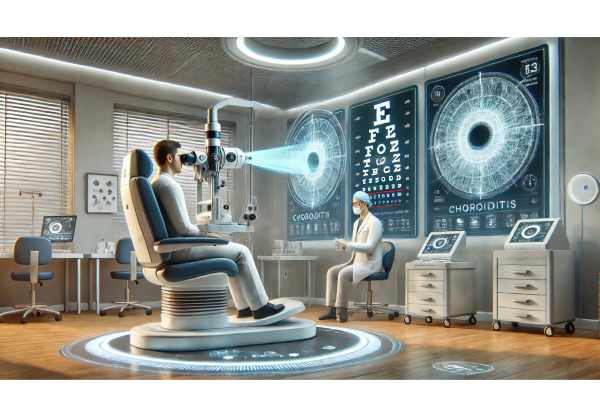
Choroiditis is an inflammation of the choroid, a vital vascular layer beneath the retina that nourishes the eye. This condition may develop suddenly or gradually, and can be triggered by infections, autoimmune reactions, or unknown causes. Symptoms such as blurred vision, eye pain, or floaters can range from mild to severe, and if left untreated, choroiditis may threaten vision. Understanding the latest diagnostic strategies, therapy options, surgical interventions, and novel treatments empowers patients and families. In this comprehensive guide, we explore everything you need to know about managing choroiditis in today’s rapidly evolving landscape.
Table of Contents
- Condition Overview and Epidemiology
- Conventional and Pharmacological Therapies
- Surgical and Interventional Procedures
- Emerging Innovations and Advanced Technologies
- Clinical Trials and Future Directions
- Frequently Asked Questions
- Disclaimer
Condition Overview and Epidemiology
Choroiditis refers to inflammation of the choroid, the middle, blood vessel-rich layer of the eye. This inflammation may be isolated or occur alongside other ocular structures, often described as posterior uveitis. Choroiditis can be categorized as infectious (caused by bacteria, viruses, fungi, or parasites) or non-infectious (linked to autoimmune diseases or idiopathic origins).
Understanding Causes and Types:
- Infectious Choroiditis: May arise from tuberculosis, syphilis, toxoplasmosis, herpes viruses, or fungal infections.
- Non-Infectious Choroiditis: Often associated with conditions like sarcoidosis, Behçet’s disease, or idiopathic multifocal choroiditis.
- Granulomatous vs. Non-Granulomatous: Granulomatous choroiditis features distinct nodules, while non-granulomatous presents as diffuse inflammation.
Prevalence and Demographics:
- Choroiditis can affect individuals of any age, though certain infectious causes are more prevalent in specific regions or populations.
- Non-infectious forms are often seen in young to middle-aged adults.
Risk Factors:
- Immunosuppression: Increases vulnerability to infectious choroiditis.
- Systemic Autoimmune Diseases: Conditions like rheumatoid arthritis or lupus raise the risk.
- Geographical Exposure: Areas with high tuberculosis or parasitic infection rates see more infectious choroiditis.
Symptoms and Complications:
- Blurred or decreased vision
- Eye pain or redness
- Light sensitivity (photophobia)
- Floaters (spots or threads drifting in vision)
- If untreated, complications such as retinal detachment, macular edema, or permanent vision loss may develop.
Diagnosis Essentials:
- Eye exam (dilated fundus exam)
- Imaging: Optical coherence tomography (OCT), fluorescein angiography, and ultrasonography
- Blood work and infectious disease testing if needed
Practical Advice:
If you notice sudden changes in vision, eye pain, or see floaters, seek medical attention promptly. Early detection and treatment greatly improve outcomes and protect vision.
Conventional and Pharmacological Therapies
Effective management of choroiditis often begins with prompt pharmacological intervention, tailored to the underlying cause. Early therapy is essential to prevent permanent damage to the retina or optic nerve.
First-Line Treatments:
- Corticosteroids:
- Oral, injectable, or topical steroids are the mainstay for non-infectious choroiditis.
- Prednisone is often started at high doses, then tapered.
- Periocular (around the eye) steroid injections may be used for localized inflammation.
- Antimicrobial Agents:
- Antibiotics for bacterial infections (e.g., syphilis, tuberculosis).
- Antiviral medications for herpes viruses (e.g., acyclovir).
- Antifungal or antiparasitic drugs as indicated (e.g., for toxoplasmosis).
Steroid-Sparing and Immunomodulatory Drugs:
- For chronic or steroid-dependent non-infectious choroiditis:
- Methotrexate, mycophenolate mofetil, azathioprine, cyclosporine, or biologics (like adalimumab) may be prescribed to control inflammation and reduce steroid side effects.
Adjunctive Therapies:
- Topical cycloplegics to relieve pain from ciliary spasm.
- Nonsteroidal anti-inflammatory drugs (NSAIDs), sometimes as an add-on.
Monitoring and Follow-Up:
- Frequent eye exams to assess response and detect side effects.
- Blood work for systemic medications.
Supportive Measures:
- Protective sunglasses to reduce photophobia.
- Healthy lifestyle: Avoid smoking, manage chronic conditions, maintain a balanced diet.
Practical Advice:
Follow your treatment plan carefully, attend all follow-up visits, and notify your doctor promptly if new symptoms develop. Never stop steroids abruptly without medical supervision.
Surgical and Interventional Procedures
While most cases of choroiditis respond to medical therapy, certain situations require surgical intervention—especially when complications threaten sight.
When is Surgery Considered?
- Non-resolving choroidal inflammation
- Sight-threatening complications such as retinal detachment, vitreous hemorrhage, or persistent macular edema
- Diagnostic uncertainty requiring tissue biopsy
Key Surgical Procedures:
- Pars Plana Vitrectomy:
- Removes the vitreous gel to clear vision obscured by inflammatory debris or blood.
- Enables direct treatment (laser or drug delivery) and facilitates diagnostic sampling.
- Retinal Detachment Repair:
- Surgical reattachment of the retina if detachment occurs due to chronic inflammation or scarring.
- Sub-Tenon’s or Intravitreal Steroid Implants:
- Provide long-term local steroid delivery for chronic inflammation, reducing the need for systemic medication.
- Laser Photocoagulation:
- Used selectively to seal leaking blood vessels or treat neovascularization (abnormal new vessel growth).
Perioperative Considerations:
- Close coordination between ophthalmologists and rheumatologists/infectious disease specialists for patients on immunosuppression.
- Postoperative monitoring for infection, inflammation rebound, or pressure changes.
Minimally Invasive Techniques:
- Micro-incision vitrectomy
- Office-based intravitreal injections for localized therapy
Practical Advice:
If surgery is recommended, ask about risks, recovery time, and how the procedure will impact your vision and daily activities. Good communication ensures your concerns and expectations are addressed.
Emerging Innovations and Advanced Technologies
Recent breakthroughs are reshaping choroiditis management, offering hope for improved outcomes even in complex or chronic cases.
Biologic Therapies and Precision Medicine:
- Monoclonal antibodies (e.g., adalimumab, infliximab) target specific immune pathways, providing more targeted and often better-tolerated treatment for autoimmune or idiopathic choroiditis.
- Individualized medicine leverages genetic and biomarker data to tailor drug choices and doses.
Long-Acting Implants:
- Fluocinolone acetonide and dexamethasone implants deliver continuous steroid therapy inside the eye for up to several months.
- Benefits: Reduce need for frequent injections and maintain stable drug levels.
Gene and Cell Therapy:
- Experimental studies are exploring gene editing and stem cell therapies to repair damaged ocular tissues or rebalance immune responses, particularly for recurrent or severe cases.
Artificial Intelligence in Diagnosis and Monitoring:
- AI-enhanced imaging software can detect subtle inflammatory changes, allowing earlier intervention and personalized monitoring schedules.
- Predictive analytics may help forecast flares or response to therapy.
Novel Diagnostic Imaging:
- Ultra-widefield retinal imaging captures more of the retina in a single view, helping track inflammation spread or resolution.
- OCT angiography provides high-resolution maps of blood flow, aiding in early detection of neovascularization.
Telemedicine and Remote Monitoring:
- Secure video consultations and remote retinal imaging now support ongoing care for chronic or rural patients.
Practical Advice:
Discuss with your eye care team whether you might benefit from new technologies or clinical trials. Staying current on advances can help you make the best choices for your unique situation.
Clinical Trials and Future Directions
Choroiditis research is rapidly expanding, fueled by advances in immunology, drug delivery, and regenerative medicine.
Current Research Areas:
- Next-generation immunomodulators with fewer side effects and better efficacy
- Cell-based therapies aiming to regenerate retinal tissue damaged by inflammation
- Personalized medicine to match patients with the most effective drugs based on genetic or molecular profiles
- AI-driven platforms for automated monitoring, early relapse detection, and prediction of outcomes
Ongoing and Upcoming Clinical Trials:
- New biologic drugs for steroid-resistant or refractory choroiditis
- Sustained-release intraocular implants
- Comparative trials of oral versus injectable immunosuppressants
Participating in Trials:
- Eligibility depends on choroiditis type, severity, previous treatments, and overall health.
- Potential benefits include access to cutting-edge therapies, expert monitoring, and contributing to medical progress.
What the Future May Hold:
- Safer, more precise therapies that minimize side effects while providing durable control of inflammation
- Early intervention protocols for at-risk patients
- Integrated care models combining vision rehabilitation, psychological support, and medical therapy
Practical Advice:
If you are interested in research participation, consult your ophthalmologist or check registries like ClinicalTrials.gov. Advocacy organizations are also valuable sources for trial updates and patient support.
Frequently Asked Questions
What is choroiditis and how is it diagnosed?
Choroiditis is inflammation of the choroid, a vascular layer in the eye. It’s diagnosed through an eye exam, imaging (like OCT and fluorescein angiography), and sometimes blood tests to find the underlying cause.
What are the most effective treatments for choroiditis?
The best treatments depend on the cause. Steroids are commonly used for non-infectious types, while antibiotics, antivirals, or antifungals are needed for infectious cases. Immunomodulators help in chronic or severe inflammation.
Can choroiditis lead to permanent vision loss?
Yes, untreated or severe choroiditis can cause complications like retinal scarring or detachment, leading to irreversible vision loss. Early treatment and regular follow-up are key to preserving sight.
Is surgery necessary for choroiditis?
Surgery is not always needed. It’s reserved for complications such as retinal detachment, vitreous hemorrhage, or when medical therapy fails to control the inflammation.
How long does treatment for choroiditis usually last?
Treatment duration varies. Acute cases may resolve in weeks, while chronic choroiditis often requires months to years of management and monitoring to prevent relapses.
What lifestyle changes can support choroiditis recovery?
Protecting eyes from bright light, following medication plans, not skipping follow-up visits, eating a balanced diet, and avoiding smoking all support better recovery and eye health.
Are there any new treatments for choroiditis?
Yes, new options include biologic drugs, long-acting steroid implants, and gene therapy—all in clinical trials or recently approved for certain cases. Ask your specialist about eligibility for innovative treatments.
Disclaimer
The information provided in this article is for educational and informational purposes only. It is not a substitute for professional medical advice, diagnosis, or treatment. Always consult your physician or eye care specialist with any questions or concerns regarding your health or vision.
If you found this article helpful, please consider sharing it with friends, family, or anyone who might benefit—on Facebook, X (formerly Twitter), or any platform you prefer. Your support helps us continue to create high-quality, accessible health information. Follow us on social media for the latest updates. Thank you for being part of our community!










